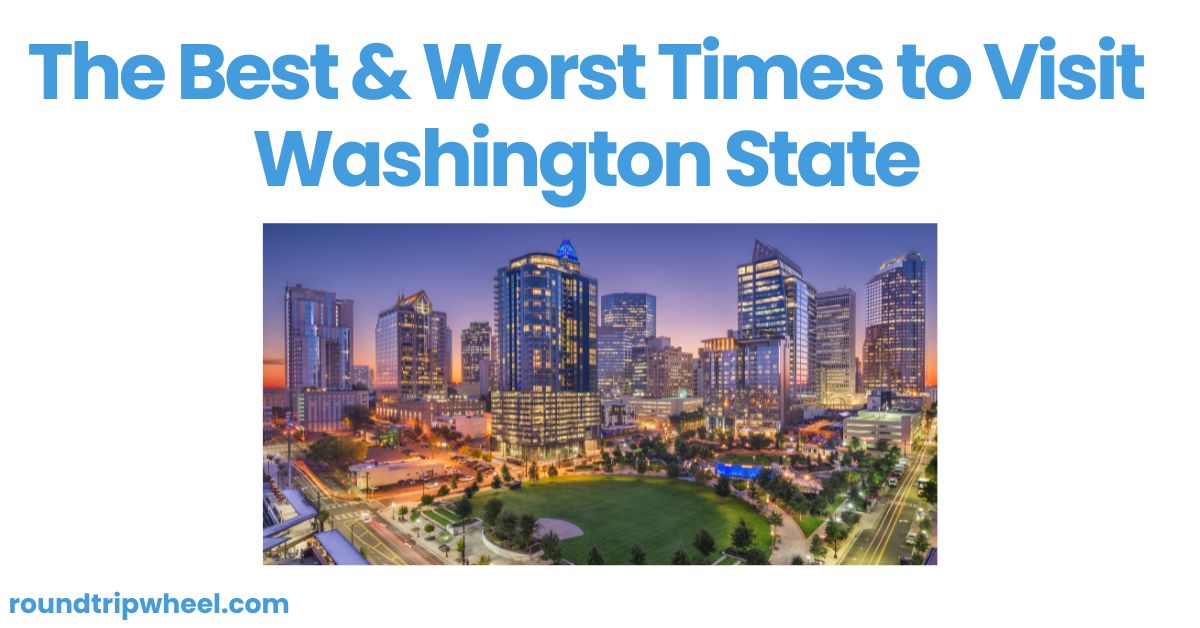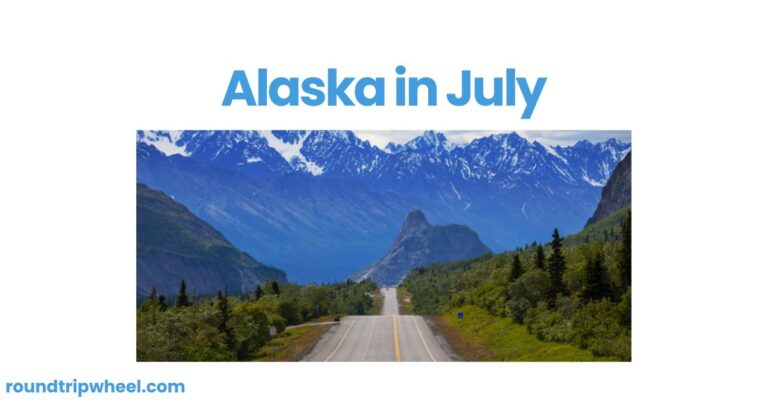The Best & Worst Times to Visit Washington State

With its diverse landscapes ranging from lush rainforests and towering mountain ranges to sparkling lakes and rugged coastlines, Washington State offers an abundance of natural beauty and outdoor adventures. However, timing your visit wisely can significantly enhance your experience in this remarkable Pacific Northwest destination. In this comprehensive guide, we’ll explore the prime seasons to visit, as well as the times when certain factors may dampen your trip, helping you plan the ultimate Washington State getaway.
The Best Times to Visit Washington State
Summer (July-August)
Summer is undoubtedly one of the prime times to visit Washington State, especially for those seeking warm, dry weather and longer daylight hours for outdoor pursuits. During July and August, the state basks in its sunniest and driest conditions, making it ideal for hiking, camping, water sports, and exploring the stunning national parks.
The San Juan Islands, known for their picturesque landscapes and abundant wildlife, including the iconic orca whales, are particularly popular during the summer months. Visitors can indulge in kayaking, whale-watching tours, and leisurely strolls along the pristine beaches.
Mount Rainier National Park, a crown jewel of the state, offers prime hiking conditions, with wildflowers in full bloom and the snow-capped peaks standing in stark contrast against the clear skies. The Paradise area, a hiker’s paradise, boasts an array of scenic trails, including the iconic Skyline Trail, which treats adventurers to breathtaking vistas of glaciers, valleys, and the majestic Rainier.
It’s worth noting that while summer is peak season, it also brings larger crowds and higher accommodation prices. Early booking is recommended, especially for popular destinations like the San Juan Islands and national parks.
Early Fall (September-October)
For those seeking fewer crowds and milder temperatures, early fall is an excellent time to visit Washington State. The months of September and October offer a delightful respite from the summer hustle, with the foliage beginning to transition into a vibrant tapestry of reds, oranges, and golds.
During this shoulder season, many hiking trails and campgrounds remain open, providing ample opportunities to immerse yourself in the state’s natural splendor without the summer crowds. The weather is often dry and pleasant, making it an ideal time for outdoor activities like cycling through the picturesque wine regions or embarking on a scenic road trip along the stunning byways.
Early fall is also a prime time for food and wine enthusiasts, as the harvest season is in full swing. Wineries across the state, particularly in the renowned Walla Walla and Yakima Valley regions, offer tastings and special events, allowing visitors to savor the local bounty.
The Worst Times to Visit Washington State
Winter (November-March)
While winter in Washington State can be a magical time, particularly for those seeking winter sports, it’s generally considered the least favorable season for most travelers. The months between November and March are characterized by frequent rain, gusty winds, and cooler temperatures, especially in the western regions of the state.
In the Cascade Mountains and Olympic Peninsula, heavy snowfall can pose challenges for outdoor enthusiasts, as many trails and campgrounds may be inaccessible or closed. However, this is also the prime time for winter sports enthusiasts, as ski resorts like Snoqualmie, Crystal Mountain, and Stevens Pass welcome skiers and snowboarders to their powdery slopes.
For those hoping to explore the cities, such as Seattle, during the winter months, be prepared for a gloomy ambiance, with frequent gray skies and persistent drizzle. However, this can also be an opportunity to embrace the cozy indoors, indulging in Seattle’s vibrant culinary scene, visiting museums, or cozying up in a local café or bookstore.
Spring (April-May)
While spring in Washington State can be a delightful time, with blooming wildflowers and mild temperatures, it’s often characterized by unpredictable weather patterns. April and May can bring a mix of sunshine, rain showers, and even occasional snowfall in higher elevations.
The shoulder season of spring can present challenges for outdoor enthusiasts, as many hiking trails and campgrounds may still be closed or muddy due to melting snow and rainfall. However, for those willing to embrace the unpredictability, spring offers opportunities for witnessing the state’s natural beauty in transition, with vibrant blossoms adorning the landscapes and newborn wildlife emerging.
Additionally, spring is a popular time for whale watching, as gray whales migrate along the coast, making their way from the warm waters of Mexico to the rich feeding grounds of Alaska. Visitors can embark on whale-watching tours from various coastal towns, including Westport and Port Angeles, to witness these majestic creatures in their natural habitat.
Factors to Consider When Planning Your Visit
Weather Patterns
Washington State’s diverse geography and proximity to the Pacific Ocean contribute to its variable weather patterns. While the western regions experience a maritime climate with frequent rainfall and cooler temperatures, the eastern regions have a more continental climate, with drier conditions and greater temperature extremes.
It’s essential to research the specific weather patterns of your intended destination within the state. For instance, the Olympic Peninsula is known for its lush rainforests and abundant precipitation, while the eastern regions, like the Tri-Cities area, enjoy a semi-arid climate with hot summers and cold winters.
Crowds and Peak Seasons
Certain times of the year, particularly during the summer months and major holidays, can bring larger crowds to popular destinations within Washington State. National parks, coastal towns, and outdoor recreation areas may experience increased visitation, leading to longer lines, limited availability of accommodations, and potential overcrowding.
If you prefer a quieter and more serene experience, consider visiting during the shoulder seasons or off-peak times. Early fall and late spring can be excellent options, offering milder weather and fewer crowds, while still providing ample opportunities for outdoor adventures.
Special Events and Festivals
Washington State hosts a wealth of cultural events, festivals, and celebrations throughout the year, many of which can influence your travel plans. From the vibrant Seafair Festival in Seattle during the summer to the captivating Leavenworth Christmas Lighting Festival in the winter, these events can add a unique dimension to your visit.
If you’re interested in attending a specific event or festival, plan your trip accordingly, as accommodations and transportation may be in higher demand during these times. Conversely, if you prefer to avoid the crowds and festivities, it may be wise to plan your visit around these events.
Outdoor Activities and Interests
Your specific travel interests and desired outdoor activities should also play a significant role in determining the best time to visit Washington State. For avid hikers and backpackers, the summer months offer prime conditions, with pristine trails and longer daylight hours.
On the other hand, if winter sports like skiing, snowboarding, or snowshoeing are your passion, the winter months from December to March will provide ample opportunities to hit the slopes and embrace the powdery landscapes.
Anglers may find the spring and fall seasons ideal for fishing in the state’s rivers and lakes, while beach enthusiasts might prefer the warmer summer months for coastal exploration and water activities.
No matter your interests or preferences, Washington State offers an array of experiences throughout the year, making it a versatile destination for travelers of all kinds.
Conclusion
With its diverse landscapes, varied weather patterns, and abundance of outdoor activities, Washington State presents a multitude of opportunities for adventure and exploration. While summer and early fall are generally considered the prime seasons, offering warm weather and optimal conditions for hiking, camping, and outdoor pursuits, the winter and spring seasons hold their own unique charms.
Ultimately, the best time to visit Washington State depends on your personal preferences, travel interests, and desired experiences. Whether you seek the sun-drenched days of summer, the vibrant colors of fall, the powdery slopes of winter, or the rebirth of spring, this remarkable state has something to offer every traveler.
By carefully considering factors such as weather patterns, crowds, special events, and your preferred outdoor activities, you can plan your visit to Washington State during the most suitable time, ensuring a memorable and fulfilling journey through this natural wonderland of the Pacific Northwest.

About Author
Hey there, fellow explorers! I’m Mark Rodriguez, a big fan of adventures and always hungry for more. Packed with stories and a trusty camera, I’m on a mission to explore cool places around the world.
I love diving into new cultures and landscapes. As a travel writer, my goal is to get you excited about stepping out of your comfort zone, trying new things, and discovering the awesome magic our world has.
Check out my blog for cool stories, travel ideas, and helpful tips to plan your own amazing getaway!





